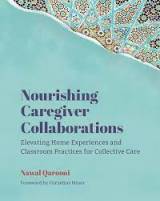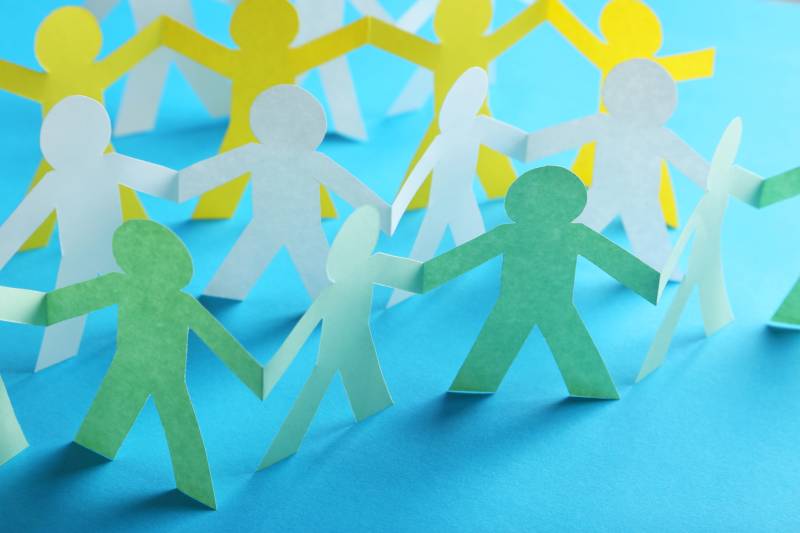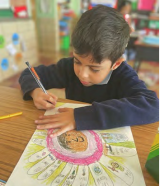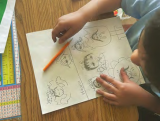From Nourishing Caregiver Collaborations: Elevating Home Experiences and Classroom Practices for Collective Care by Nawal Qarooni © 2024 by Stenhouse Publishers/Taylor & Francis. Reproduced with permission.
 No doubt, you’re familiar with the traditional family tree project. My own kids come home with these year after year, a stenciled outline that they need to fill in with great-grandparents, grandparents, parents, and siblings. For my children, being raised in a two-parent household with strong connections to both sets of grandparents, this has been a fine project that goes fairly smoothly in each instance. A few phone calls to Mama Mahnaz and Abuelo get them the names of family members from Iran and Puerto Rico that they need. But as we know, all families are different. These family tree projects have the potential to be both frustrating for students and alienating to their caregivers. When I spoke with longtime educator and school leader Nefertari Nkenge, she shared such an example of frustration about her daughter’s experience, particularly around a “normed expectation of who lives in the house.”
No doubt, you’re familiar with the traditional family tree project. My own kids come home with these year after year, a stenciled outline that they need to fill in with great-grandparents, grandparents, parents, and siblings. For my children, being raised in a two-parent household with strong connections to both sets of grandparents, this has been a fine project that goes fairly smoothly in each instance. A few phone calls to Mama Mahnaz and Abuelo get them the names of family members from Iran and Puerto Rico that they need. But as we know, all families are different. These family tree projects have the potential to be both frustrating for students and alienating to their caregivers. When I spoke with longtime educator and school leader Nefertari Nkenge, she shared such an example of frustration about her daughter’s experience, particularly around a “normed expectation of who lives in the house.”
“It would have just been Mom and her. But she made it about 12 brothers and sisters, and that made me grin. The teacher interrogated her and made her feel some kind of way. Jendayi considered her godsiblings who spend the night; I’m Mama Nefertari to all these children; my daughter calls their mothers Aunties — so she’s listing names. The teacher says, these are your siblings? The teacher just couldn’t understand.”
A more inclusive and culturally sustaining approach would replace these experiences of othering and frustration. Nefertari contended: “Our family experiences — verbal tradition as an African people — it’s not something that’s going to be captured in a paper-and-pencil family tree. Nor is the respect we give our non-blood relatives, many of whom are elders we learn from. It would never get the depth of what I shared now, or what my daughter understood in the third grade. To visualize and draw illustrations of experiences with this large family — even though it’s just the two of us — it needs the narrative for us. For Black and Brown people, for you to see the depth of what we’re describing . . . in the end, I wanted to communicate: see how rich the narrative is in who we are? That is never captured in literacy assignments in schools, nor is it captured in the ways we give credence to it in our own traditional way.”
Black, Brown and Indigenous communities, especially, have longstanding and deep understandings of the importance of the collective and, furthermore, the far-reaching relational ties that shape knowledge of ourselves and who we are. Indigenous scholar Shelbi Nahwilet Meissner writes, “Kinship, as conceived of by Indigenous scholars, does not refer merely to hetero-nuclear families or biological relatives (TallBear 2018; Whyte 2021). Rather, ‘kinship’ is used to describe the relationships between all entities that share responsibilities for one another.” And also, “Indigenous conceptions of kinship expand beyond Western conceptions of family and include relationships among humans, non-humans, animals, plants and spirits — these relationships inform Indigenous knowledge systems.” We can learn from these deeply rooted ways of being. If we are to honor all families and their ways of being, we must design curricular activities with collective inclusivity in mind.



 I imagine the objective of the original family tree exercise was never to fill in box after box in rote fashion but to
I imagine the objective of the original family tree exercise was never to fill in box after box in rote fashion but to  Some people who have played an enormous role in raising me would never have shown up on a traditional family tree graphic organizer. Amu Hamid, with his ceaseless guidance, unending support and unconditional love, wouldn’t have had a place on a simple stencil, because he was my father’s sister’s husband. But the reality is, he was one of the people who raised me. I was one of his daughters. He piloted my daily decision making with compassion, care, and experience. If I were a student able to design the outline of my adult community, he would’ve shown up as the family giant.
Some people who have played an enormous role in raising me would never have shown up on a traditional family tree graphic organizer. Amu Hamid, with his ceaseless guidance, unending support and unconditional love, wouldn’t have had a place on a simple stencil, because he was my father’s sister’s husband. But the reality is, he was one of the people who raised me. I was one of his daughters. He piloted my daily decision making with compassion, care, and experience. If I were a student able to design the outline of my adult community, he would’ve shown up as the family giant. learning all families gift their children every day. She and her team of coaches at NQC Literacy work with schools and districts to collectively grow teacher practice and children’s literacy lives. In addition, she is a member of the National Council for Teachers of English Committee Against Racism and Bias in the Teaching of English; she evaluates manuscripts for Reese Witherspoon’s LitUp program, which platforms historically underrepresented voices in publishing; and she serves on the Library of Congress Literacy Awards Advisory Board, which funds powerful literacy programming across the country. Nawal holds a Bachelor of English from the University of Michigan, a Master of Teaching from Brooklyn College and a Master of Journalism from Syracuse University’s Newhouse School. She won a New Jersey Press Association Award for her international reporting and transitioned into education as a New York City Teaching Fellow.
learning all families gift their children every day. She and her team of coaches at NQC Literacy work with schools and districts to collectively grow teacher practice and children’s literacy lives. In addition, she is a member of the National Council for Teachers of English Committee Against Racism and Bias in the Teaching of English; she evaluates manuscripts for Reese Witherspoon’s LitUp program, which platforms historically underrepresented voices in publishing; and she serves on the Library of Congress Literacy Awards Advisory Board, which funds powerful literacy programming across the country. Nawal holds a Bachelor of English from the University of Michigan, a Master of Teaching from Brooklyn College and a Master of Journalism from Syracuse University’s Newhouse School. She won a New Jersey Press Association Award for her international reporting and transitioned into education as a New York City Teaching Fellow.